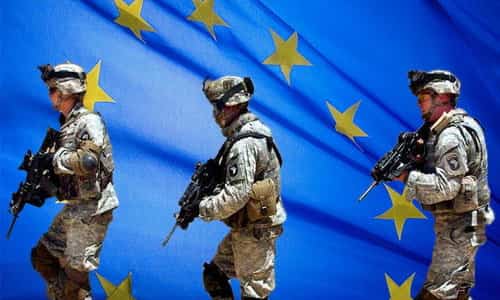Germany & France Quietly Building EU Army
 By PNW Staff June 23, 2017
Share this article:
By PNW Staff June 23, 2017
Share this article:
Slowly and quietly the countries of the European Union are building
an integrated military force that will soon be a European Union
military in all but name.
Britain has
long-maintained its preference for NATO over an EU force and has used
its influence to block any moves towards a common European armed
forces.
But with Brexit now a reality, there
seems to be little standing in the way of the ambitions of France and
Germany to lead the EU to realize its ambition of marshalling its own
army.
Rather than a single, open political
movement in favor of a common EU army, several member states have taken
incremental steps to consolidate specific units, divert defense funds
into sequestered accounts and create new coordinated command
structures.
Language, finances and national
sentiment have promise to be obstacles to a single-force structure, but
these too are being faced down by French and German initiatives as a
host of other European nations follow their lead.
Coordination
The
European Union is, despite the intentions of those in Brussels, a union
of separate and distinct nationalities, governments, languages and
militaries.
The first and most basic challenge that any proposal for a
unified military will face is that of coordination among different
command structures. For the first time, the EU created in March a joint
military command center.
It is more akin to a
proof-of-concept effort at this point, as its only mission is
coordinating training missions in Africa (Somalia, Mali and the Central
African Republic).
The headquarters will act
as a model, however, for larger future centralized command centers
capable of coordinating large-scale military campaigns.
Other
coordinated efforts from Europe include the Nordic Battle Group
comprised of a mix of Baltic and Nordic states and the Britain's own
Joint Expeditionary Force.
The Nordic Battle
Group is only 2,400 strong but the experience gained from coordinating
such a collection of nations will be invaluable for the project of
larger European military integration.
Funding
The
second major obstacle is funding both of national militaries and of a
joint European force. A newly proposed European Defense Fund would
gather financial support for military research and armament from member
nations and is projected to begin with a modest funding goal of 3.5
billion Euros from the 19 countries now supporting the proposal.
The
countries, which include France, Germany, Italy and Spain, would also
benefit from sharing research and resources that would otherwise be
duplicated across 19 national systems.
Jean-Claude
Juncker, the President of the European Commission, told the German news
site Salzburg.com that "A European army is not a project for the near
future.
It is, however, a project that would
give additional weight to the European foreign and security policy. Even
though the road may still be long, we could already focus our strengths
better."
The politicians at the head of the EU
understand that small steps are necessary to create a common military
over the nationalist sentiments of the European people.
The
Cooperative Financial Mechanism, or CFM, could begin drawing funds from
the 19 countries as early as 2018, but if successful will be just the
first step towards a common financial base for the European military.
Integration
Coordinating
military campaigns from separate national militaries and starting to
form a common defense fund are both incremental steps towards a EU
military, but true integration is also now underway through the German
Army, the Bundeswehr.
In what amounts to a
group of mini-armies under the command of the Bundeswehr, the
Netherlands, Romania and the Czech Republic have all integrated
brigade-level forces with Germany. The program is known as the Framework
Nations Concept.
In the case of Romania, it is
the 81st Mechanized Brigade which will join Germany's Rapid Response
Forces Division. The Czech Republic's 4th Rapid Deployment Brigade,
considered the elite frontline force of their army, is now set to
integrate into the Germans' 10th Armored Division.
After
selling off all their tanks, the Dutch military integrated one of their
brigades into Germany's 10th Armored Division as well as combining
another brigade with Germany's Rapid Deployment Brigade.
Although
no separate military force was created that would fly the EU flag on
the battlefield, the result is the same as each member state slowly
begins to integrate one brigade at a time into a common armed forces
system, all under one command.
In this manner, there has been very little objection and most haven't even noticed the change.
At the same time, the German military is growing both in size
and funding levels. Since 2014, the Bundeswehr has seen its funding
increased by 4.2 percent and this is projected to grow an incredible 8
percent this year.
As the overall cost-savings
become clear for EU nations, it is likely that more countries will
choose to integrate into the larger military force commanded by Germany.
Europe
faces historic threats to its existence that range from financial, with
the slow collapse of both the euro and the socialist model, to
cultural, with the immense wave of immigration.
Russian
aggression and the dangers of Islamic terrorism also wait at Europe's
doorstep. All of these factors are likely to push the continent closer
to a common European military in the coming years, especially without
the counterweight of Britain to argue the case for NATO.
Will
a fully unified EU someday soon be defended by a military to rival that
of the United States in size, capability and cohesion? The bureaucrats
in Brussels would like nothing more.

No comments:
Post a Comment